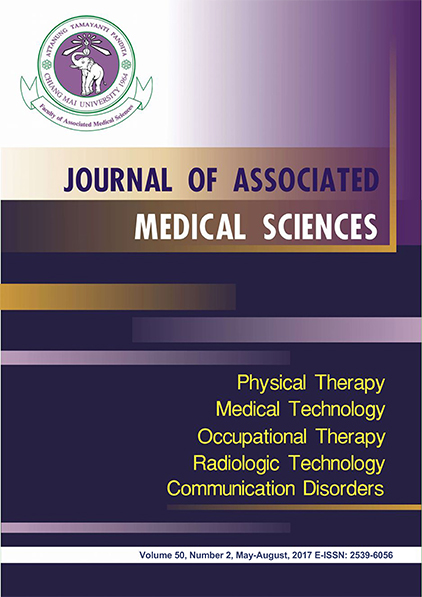Sexual behavior and attitudes regarding sexual transmitted disease among foreigners in Chiang Mai City Chiang Mai Province
Main Article Content
Abstract
Background: Recently, number of foreigners visiting Thailand has been increased. Increasing in sexual transmitted infections, thus, was affected because many foreigners may engage in risky sexual behavior while traveling.
Objectives: The aim of this study was learning about sexual behavior, and attitudes regarding sexually transmitted diseases, among foreigners in Chiang Mai city of Chiang Mai Province.
Materials and methods: It was a descriptive study of foreigners aged 18 years or older. Four hundred questionnaires were collected from foreigners around Thapae Gate, Night Bazaar, and Loi Kroh road during May-June 2016
Results: Fifty-seven percent of participants were male and 43% were female. Sixty-five percent were 18-29 years old. Foreigners (54%) came from European countries with duration of their stay in Chiang Mai less than 14 days (59.8%). Most of them (84.8%) reported having sex while staying in Chiang Mai and some had more than one sexual partner (22.5%). Sixty-four percent of those didn’t use condoms with their regular partner but did when having causal sex with a new partner. Some (15.5%) reported having a sexually transmitted disease in their life (15.5%) and 67% had ever taken STDs test. Most participants have normal attitude about risks attached to sexual behavior and a good attitude towards the use of condoms.
Conclusion: Some foreigners visiting Chiang Mai Province frequency reported unsafe sexual practices; risky sexual behavior such as having multiple partners, and irregular use of condoms. These participants, therefore, are at the greatest risk of contracting sexually transmitted diseases. This information can be used as guideline for the sexual transmitted disease prevention between foreigners and local Thai people in Chiang Mai Province and other significant tourist areas in the future.
Journal of Associated Medical Sciences 2017; 50(2): 159-167. Doi: 10.14456/jams.2017.17
Article Details

This work is licensed under a Creative Commons Attribution-NonCommercial-NoDerivatives 4.0 International License.
Personal views expressed by the contributors in their articles are not necessarily those of the Journal of Associated Medical Sciences, Faculty of Associated Medical Sciences, Chiang Mai University.
References
2. Alcedo S, Kossuth-Cabrejos S, Piscoya A, Mayta-Tristán P. Factors associated with non-use of condoms in an online community of frequent travellers. Travel Med Infect Dis. 2014; 12(6): 750-6.
3. Cabada MM, Echevarria JI, Seas C, Gotuzzo E. High prevalence of sexually transmitted infections among young Peruvians who have sexual intercourse with foreign travelers in Cuzco. J Travel Med. 2009; 16(5): 299-303.
4. Kaehler N, Piyaphanee W, Kittitrakul C, Kyi YP, Adhikari B, Sibunruang S, et al. Sexual behavior of foreign backpackers in the Khao San Road area, Bangkok. Southeast Asian J Trop Med Public Health. 2013; 44(4): 690-6.
5. ฐานข้อมูลการท่องเที่ยวเชิงการตลาด [Internet]. สำนักเทคโนโลยีสารสนเทศ กลุ่มฐานข้อมูลการตลาด. 2558 [cited 2/9/2558]. Available from: http://marketingdatabase.tat.or.th/ewt_w3c/ewt_news.php?nid=1621.
6. Vivancos R, Abubakar I, Hunter P. Foreign travel, casual sex, and sexually transmitted infections: systematic review and meta-analysis. Int J Infect Dis. 2010; 14(10): e842-e51.
7. Downing J, Hughes K, Bellis MA, Calafat A, Juan M, Blay N. Factors associated with risky sexual behaviour: a comparison of British, Spanish and German holidaymakers to the Balearics. The European Journal of Public Health. 2011; 21(3): 275-81.
8. Cabada MM, Montoya M, Echevarria JI, Verdonck K, Seas C, Gotuzzo E. Sexual behavior in travelers visiting Cuzco. J Travel Med. 2003; 10(4): 214-8.
9. Hughes K, Downing J, Bellis MA, Dillon P, Copeland J. The sexual behaviour of British backpackers in Australia. Sex Transm Infect. 2009; 85(6): 477-82.
10. Mercer CH, Fenton KA, Wellings K, Copas AJ, Erens B, Johnson AM. Sex partner acquisition while overseas: results from a British national probability survey. Sex Transm Infect. 2007; 83(7): 517-22.


